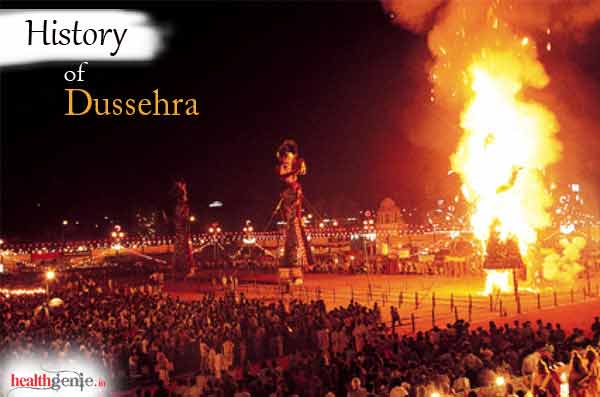Dussehra is one of the most important festival of Hindu religion which is celebrated in various forms across India, Nepal & Bangladesh. It is also known as Vijaydashami, Navratri or Durgotsav, Dashain (in Nepal).
As the name suggests, Vijaydashami is celebrated on the 10th day of Ashwin month which corresponds to September or October month according to Gregorian calendar. The first nine days are celebrated as Navaratri or Durga Puja or Sharda Navratri and culminates on the 10th day as Vijaydashami. Since ages, this festival is celebrated with pomp and happiness and many rites and rituals are performed on this delightful occasion.
Some of the spirited and vibrant histories related to this festival are as follows:
History of Dussehra
Conquest of Lord Rama over Raavan:
As per Hindu religion, on this day, Lord Rama, seventh incarnation of Vishnu, killed ten headed demon Raavan who seized Sita, wife of Lord Rama. Lord Rama with his younger brother Lakshman, their follower Hanuman and an army of monkeys superintended Lanka, fought a battle with Raavan and defeated him. Lord Rama took blessings from Durga Ma by organizing Chandi Puja on his way and she gave the secret to kill Raavan. Therefore the day is celebrated to honor the triumph of Lord Rama over Raavan which later came to be known as Vijaydashami.
Slaughter of Mahishasura by Goddess Durga:
According to this story, Mahishasur, who was in the form of buffalo was very powerful and created devastation. All the Devas as well as living beings were upset by his autocracy. He was undefeatable even by the almighties. Therefore all the Gods decided to create a power and a single mass of incandescent energy emerged in the form of beautiful female virgin who was Goddess Durga from the mouths of Lord Brahma, Lord Vishnu and Lord Shiva to kill Mahishasur. All the Gods gave their weapons to her and the power and she riding on a lion fought with Mahishasur. This battle was continued for 9 days and nights and on the 10th day she killed the Asur and restored the swargalok to the Devas. Hence Dussehra is also known as Durgotsav describing the victory of Goddess Durga.
Homecoming of Durga Mata:
Sati, daughter of Daksha (Lord of earth) & Prasuti started worshiping Lord Shiva as her would be husband. Lord Shiva was pleased and married her but Satis parents were against from this marriage. Once , Daksha organized a Yagya in which everyone was invited except Lord Shiva. Sati couldn’t bear this insult of her husband and killed herself. Lord Shiva was in agony when knew this and lifted Satis body on his shoulder and started dancing with outrage and the world was on the verge of destruction. Then Lord Narayana saved by cutting Satis body into pieces by his chakra and pieces scattered throughout the Indian subcontinent from the dancing body of Shiva. Shiva was placated when the last piece was fallen down. Lord Narayana resuscitated Sati. The places are known as Shakti Piths where pieces of Sati fell. In her next birth, Sati was born as Parvati, daughter of Himalaya. Lord Shiva forgave Daksha and Parvati with her children Ganesh, Kartikeya came back to Lord Shiva. Every year Parvati visit her parents during autumn or sharatkal, when Durga Puja is celebrated.
Guru Dakshina of Kautsa:
Kautsa was the son of a Brahman, Devdatta and lived in Paithan. He was getting education under the guidance of Rishi Varatantu. After completing the education, he wanted to give guru dakshina to his Guru but Rishi Varatantu refused to take anything. On approaching of Kautsa, Rishi demanded 140 million gold coins, 10 million for each of the 14 sciences he taught Kautsa. He went to King Raghuraj who was famous for his liberality. Within 3 days of Kautsa’s request, Raghuraj requested Kuber (God of Wealth) to create rain of gold coins near Shanu & Aapati trees around Raghuraj’s kingdom, Ayodhya. The King gave the coins to Kautsa and he gave to Rishi Varantatu but some coins were left. As Kautsa was not interested in money, he distributed all the gold coins among beggars and needy on the day of Ashvin Shukla Dashami. In remembrance of this event, people pluck the leaves of Aapati tree and present each other as a gold.
Shami Tree:
Another legend is connected to Mahabharata. According to this story, Pandavas were defeated in gambling by Kauravas. Pandavas were deported for 12 years and 1 year of disguise as a punishment given by the Kauravas. Since Pandavas were asked to remain unidentified during their exile, they didn’t want to be exposed. Therefore they obscured their weapons under a Shami tree and at the end of every year of exile, they used to come and check their weapons. Kauravas tried many times to trace Pandavas before the stipulated time but they failed. When 12 years of exile were completed, Pandavas took their weapons and fought with Kauravas and defeated them. Good got victory over evil and this event took place on dashami, it came to be known as Vijaydashami. Since then people hug each other under shami tree and exchange its leaves.






























































